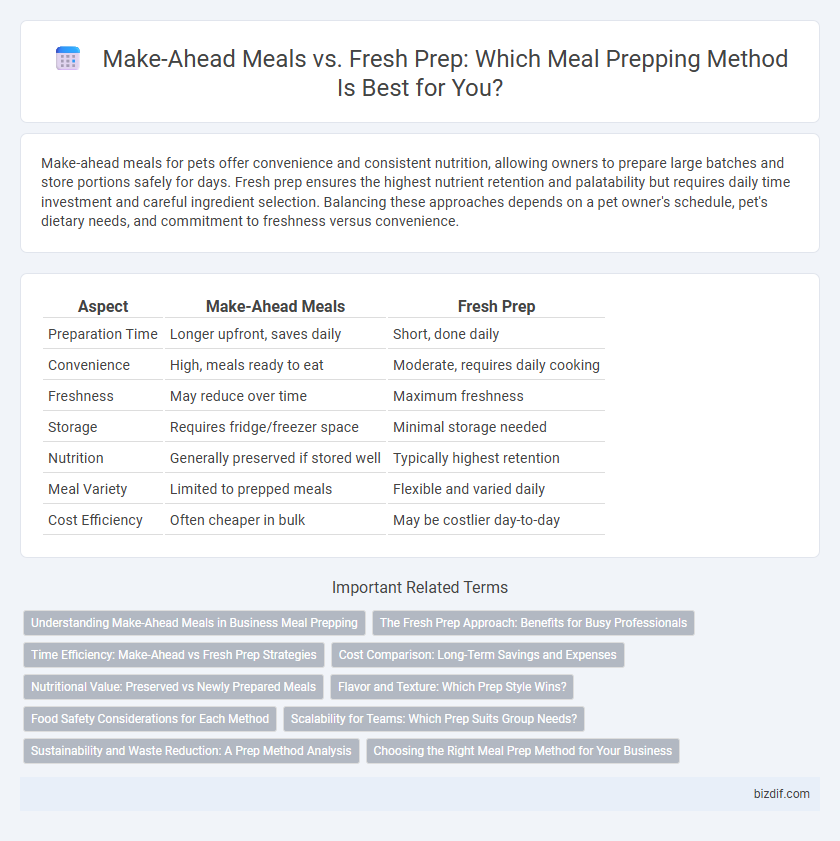Make-ahead meals for pets offer convenience and consistent nutrition, allowing owners to prepare large batches and store portions safely for days. Fresh prep ensures the highest nutrient retention and palatability but requires daily time investment and careful ingredient selection. Balancing these approaches depends on a pet owner's schedule, pet's dietary needs, and commitment to freshness versus convenience.
Table of Comparison
| Aspect | Make-Ahead Meals | Fresh Prep |
|---|---|---|
| Preparation Time | Longer upfront, saves daily | Short, done daily |
| Convenience | High, meals ready to eat | Moderate, requires daily cooking |
| Freshness | May reduce over time | Maximum freshness |
| Storage | Requires fridge/freezer space | Minimal storage needed |
| Nutrition | Generally preserved if stored well | Typically highest retention |
| Meal Variety | Limited to prepped meals | Flexible and varied daily |
| Cost Efficiency | Often cheaper in bulk | May be costlier day-to-day |
Understanding Make-Ahead Meals in Business Meal Prepping
Make-ahead meals in business meal prepping streamline operations by enabling bulk cooking and consistent portion control, reducing food waste and labor costs. These meals rely on carefully selected recipes that maintain taste and texture after refrigeration or freezing, ensuring customer satisfaction. Proper packaging and storage protocols are crucial for preserving freshness and nutritional value during extended holding periods.
The Fresh Prep Approach: Benefits for Busy Professionals
The Fresh Prep approach offers busy professionals the advantage of preparing meals shortly before consumption, ensuring optimal taste, texture, and nutritional value. This method supports maintaining a diverse diet by enabling the incorporation of seasonal ingredients and minimizing reliance on preservatives. Freshly prepared meals can enhance energy levels and productivity throughout demanding workdays by delivering vibrant, nutrient-rich options tailored to individual preferences.
Time Efficiency: Make-Ahead vs Fresh Prep Strategies
Make-ahead meals significantly enhance time efficiency by allowing batch cooking and portioning that reduce daily meal preparation to simple reheating. Fresh prep strategies, while offering peak freshness and flavor, typically require daily time investment for chopping, cooking, and plating, which can be less efficient for busy schedules. Utilizing make-ahead meal solutions supports streamlined weekly meal planning, minimizing kitchen time and optimizing daily routines.
Cost Comparison: Long-Term Savings and Expenses
Make-ahead meals often result in long-term savings by reducing food waste and allowing bulk purchases of ingredients, which lowers overall grocery expenses. Fresh prep typically incurs higher costs due to frequent shopping trips, increased energy consumption, and occasional impulse buys. Choosing make-ahead meals supports budget-friendly meal planning while maintaining nutritional value.
Nutritional Value: Preserved vs Newly Prepared Meals
Make-ahead meals often experience slight nutrient degradation due to storage and reheating processes, particularly in vitamins like C and B complex that are sensitive to heat and oxygen exposure. Freshly prepared meals typically retain higher nutritional value, as ingredients are consumed immediately, preserving water-soluble vitamins and antioxidants. However, proper storage techniques and minimal reheating can help maintain the nutritional integrity of make-ahead meals, making both options viable for balanced diets.
Flavor and Texture: Which Prep Style Wins?
Make-ahead meals often develop deeper, more integrated flavors as ingredients marinate and meld over time, enhancing taste complexity. Fresh prep maintains vibrant, crisp textures and bright, distinct flavors that can diminish during reheating or prolonged storage. Choosing between make-ahead and fresh preparation depends on balancing the convenience of rich, cohesive flavors with the desire for optimal texture and freshness.
Food Safety Considerations for Each Method
Make-ahead meals require careful cooling and reheating procedures to prevent bacterial growth, maintaining temperatures above 140degF to ensure safety. Fresh prep minimizes the risk of contamination by reducing the time food is exposed to room temperature, but requires immediate consumption or proper refrigeration within two hours. Both methods necessitate strict adherence to hygiene practices and use of airtight containers to preserve freshness and prevent cross-contamination.
Scalability for Teams: Which Prep Suits Group Needs?
Make-ahead meals offer superior scalability for teams by enabling bulk cooking and portioning that saves time and reduces daily workload, ideal for large groups needing consistent meal options. Fresh prep requires more frequent cooking and immediate consumption, making it less efficient for teams but better suited for small groups prioritizing customization and ingredient freshness. Teams should evaluate their size, scheduling flexibility, and meal variety preferences to determine if make-ahead meal prep or fresh prep best meets their collective needs.
Sustainability and Waste Reduction: A Prep Method Analysis
Make-ahead meals significantly reduce food waste by enabling precise portion control and minimizing spoilage through proper storage techniques, supporting sustainable eating habits. Fresh prep often leads to excess ingredients that can spoil quickly, increasing waste and environmental impact due to frequent grocery trips and over-purchasing. Choosing make-ahead methods promotes resource efficiency and lowers carbon footprint by consolidating meal preparation and reducing energy consumption in cooking processes.
Choosing the Right Meal Prep Method for Your Business
Selecting the optimal meal prep method depends on your business scale and customer preferences; make-ahead meals offer convenience and consistent portion control, ideal for high-volume operations. Fresh prep supports customizable, high-quality dishes with a shorter shelf life, appealing to health-conscious clientele seeking freshly cooked options. Assessing storage capacity, delivery logistics, and menu complexity ensures an efficient, cost-effective meal prep strategy tailored to your business model.
Make-Ahead Meals vs Fresh Prep Infographic

 bizdif.com
bizdif.com